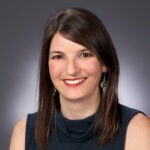Kalenda Allen-James explains the value of investing in professional development and shares a lot of free resources along the way. She’s with Commonpoint Queens.
These both continue our coverage of NTEN’s 2023 Nonprofit Technology Conference, #23NTC.
Board relations. Fundraising. Volunteer management. Prospect research. Legal compliance. Accounting. Finance. Investments. Donor relations. Public relations. Marketing. Technology. Social media.
Every nonprofit struggles with these issues. Big nonprofits hire experts. The other 95% listen to Tony Martignetti Nonprofit Radio. Trusted experts and leading thinkers join me each week to tackle the tough issues. If you have big dreams but a small budget, you have a home at Tony Martignetti Nonprofit Radio.
View Full Transcript
Transcript for 642_tony_martignetti_nonprofit_radio_20230529.mp3
Processed on: 2023-05-25T17:44:28.229Z
S3 bucket containing transcription results: transcript.results
Link to bucket: s3.console.aws.amazon.com/s3/buckets/transcript.results
Path to JSON: 2023…05…642_tony_martignetti_nonprofit_radio_20230529.mp3.687133100.json
Path to text: transcripts/2023/05/642_tony_martignetti_nonprofit_radio_20230529.txt
[00:01:47.10] spk_0:
And welcome to tony-martignetti non profit radio. Big non profit ideas for the other 95%. I’m your aptly named host of your favorite abdominal podcast. Oh, I’m glad you’re with me. I’d be stricken with S A trope AEA if I had to see that you missed this week’s show. Equitable project management, an automated soap dispenser. One of the most innocuous objects imaginable unless it doesn’t dispense soap to people with dark skin. How does bias find its way into technology projects and hurt outcomes? How can we implement technology through an equity lens? Reuben Singh from 1/10 consulting returns to help us understand and make time for professional development. Kalinda Alan James explains the value of investing in professional development and shares a lot of free resources along the way. She’s with common point queens. These both continue our coverage of N Ten’s 2023 nonprofit technology conference on Tony’s take two. Sharing is caring. We’re sponsored by Donor Box with intuitive fundraising software from donor box. Your donors give four times faster helping you help others. Donor box dot org. Here is equitable project management.
[00:02:12.99] spk_1:
Welcome back to tony-martignetti non profit radio coverage of 23 N T C. We’re kicking off our day two coverage with Ruben Sing. We are sponsored at 23 N T C by Heller consulting, technology strategy and implementation for nonprofits. Reuben Singh. My guest now is founder and CEO of 1/10 consulting Reuben. Welcome back to non private radio. Thank
[00:02:21.10] spk_2:
you, tony second or third. This is our third time chatting to
[00:02:26.03] spk_1:
virtual. Yes.
[00:02:27.27] spk_2:
Good to meet you in person. Yes, for sure. Thank you so much for having me. My pleasure to
[00:02:44.06] spk_1:
have you next to me, your session this year is managing projects with an equity lens. I think that’s pretty self explanatory. But why don’t you give us a 30,000 ft overview of why this is important for nonprofits?
[00:03:41.07] spk_2:
Yeah. You know, I, I feel like throughout my years of consulting, it’s been about 25 years of consulting. Now, I’ve, I’ve encountered some scenarios here and there that, you know, I, I’ve always thought were odd scenarios, you know, in the middle of the project, you know, working with consultants, working with our nonprofits where, you know, maybe something was borderline, discriminate, discriminatory or, you know, something just didn’t feel right. And, you know, I, when I was younger in the, in the consulting space, I didn’t really pay much mind to it. I said, hey, I’m just following, you know, my mentors and following best practices. Um you know, I’m learning the ropes. Um But, you know, as I got further in my career and I started talking to other technologists of color, other consultants. Um and uh and honestly, spaces like this at NTC where we have very frank and open discussion about race and technology and the intersection. It really um I realized a lot of these things, I was encountering these projects. We’re not, we’re not okay. They were problem at and in fact, we were allowing bias race um and uh to, to really seep its way into projects. Um And, and not only is that problematic in a, in a larger sense, but it also does not lead to good outcomes for the projects and the systems themselves. What,
[00:03:57.93] spk_1:
what does this look like? What, what kind of forms does the bias racism
[00:04:18.07] spk_2:
take? Um Well, let me give you an example if that’s OK. Yeah. So, um you know, I was working with one organization that uh you know, had really said that and actually, I was, I was very impressed with them that they had very, a very strong diversity statement, equity statement and they even extended it to their goals. They say, you know, what we’re, we have a lot of volunteers were a volunteer organization, but we um we realize that we don’t have a very diverse volunteer group. So this is going to be not only a statement of ours that we want to diversify our volunteer group, but we also want to, you know, we want to implement that in 20 you know, whatever the year was. Um, and just, what kind of work were they
[00:04:40.98] spk_1:
doing?
[00:04:42.87] spk_2:
Um, well, I mean, I don’t want to get
[00:04:45.46] spk_1:
to general
[00:05:57.20] spk_2:
social service. They, they were grassroots organizing, grassroots organizing. Let’s put it under that kind of, yeah, I mean, they’re great organization. So I’d hate to, um, I’m not asking you. Right. Right. But, but I think, um, the, uh, definitely in the, in the grassroots organizing and um you know, they kind of found that they are um uh you know, that they need to diversify their volunteer base. And I appreciated that not only was it a statement, but they had taken a step further to make it part of their goals for that particular year. But then, you know, statements aside, once we got into the project, we realized that um you know, there were certain, uh there were certain algorithms that were being that were implemented in their volunteer searches that actually filtered out a lot of criteria. So they said, oh, you know what, we, we have so many applicants, we can’t, we can’t screen everybody. So we implement these filters and the filters will, you know, the filter is kind of looking at them. I realize it’s really going to leave you with very privileged resource to people, you know, gets an education, family, education, household income, so on and so forth. And so, you know, we have this dialogue of, you know, if if these are really your goals that you want to diversify and you want different socioeconomic um groupings in your volunteer base, then you really need to reconsider this. And it was just a perfect example of how with all good intentions with great diversity statements. But even something as simple as an as an algorithm in their search um was was really letting bias find its way into the, into the implementation. And
[00:06:32.57] spk_1:
that’s an ideal example because it’s so buried. I mean, most people that may have been developed by a developer or it may have not even been developed in house, you know, some developer from like could been years ago may have created this algorithm unintentionally let’s assume biased and it just, it just perpetuates and nobody even knows that it’s there, it’s buried in code basically
[00:06:53.31] spk_2:
for sure for sure algorithms live. And if I’m a developer and someone comes to me and says we have too many applicants, we need to filter out X Y and Z to make it easier. Well, as a developer oftentimes, I’m thinking, oh how can I make this better? How can I make this more efficient? Um And they don’t really think about it. So, so this is where I think, you know, um I take it upon myself as a consultant to, to really and D I practitioner to, to raise these things because again, these organizations have great intentions. They’re just not always able to bridge the gaps unless it’s called out,
[00:07:16.45] spk_1:
unless it’s called out. Right. So, I mean, if you have something like this very deep, how would you ever discover
[00:08:06.07] spk_2:
it? Yeah, it, and that kind of goes to really the title of the session is, is managing projects with an equity lens. So the key point there is, is not really separating things. So it’s not about okay. Well, we have this diversity statement, let’s all celebrate it. And now let’s move on to our project. It’s really um taking every single part of the project anytime. In fact, when we start projects, now, I will ask for, let me see your diversity statement. Let me even if you know, chances are you may not be reflecting on it a lot. Let’s dust it off, you know, after 2020 and, and let’s take a look at it. Um And, and, and just like we review missions and visions of the organization before a project. I want to review your diversity statement that way I can make sure every step of the way I’m asking these questions because, hey, it’s your statement, it’s a priority for you. So as a, as a um a trusted partner of yours, I should make held you accountable to that.
[00:08:30.49] spk_1:
I’m just, I’m concerned, yeah, I understand we’re talking about managing projects. So from the outset concerned about organizations that have any kind of bias uh coded in somewhere that, that they just, they don’t know that. I know. I understand. We’re digressing from your topic. We got plenty of time. Yeah, we have plenty of time. You know, you’re, I’m forcing you asking you to digress, you know, but this is, this thing is buried somewhere or these things, these biases are buried. Uh, what’s our hope of ever uncovering
[00:09:23.13] spk_2:
them? Well, I mean, I think, um, you know, it’s interesting even in day one of the conference here at N T C I, I attended a couple sessions. Uh and, you know, the, the narratives are the points that I was bringing up was not just coming out of my session, but, you know, I attended a session that spoke about audience and campaigns and, you know, developing um content that’s, you know, that, that resonates with audiences um that are often overlooked. And, and, and so it was interesting because in their discussion, they were bringing up a lot of the same points that I was bringing up. So, um I’m most hopeful because of to be and I swear that intend to not put me to this. But I, I think like organizations like in 10 forums like NTC, um you know, we’re putting things out there and I think that’s what gives me hope more than anything. Um You know, we’re raising
[00:09:41.57] spk_1:
consciousness, 13,000 people are going
[00:09:43.61] spk_2:
to listen. Absolutely. So, so, I mean, if that’s, if that is, that alone gives me, it gives me a lot of hope Okay. Alright, we can
[00:10:10.60] spk_1:
circle back to your your specific topic about managing projects so that we have equity focus equity center from, from the outset. Okay. Um How are you? I’m just going to your like learning objectives, how bias finds its way into tech project? Well, I think we talked about that. It happens. I mean, I think probably do you think it’s usually innocuous?
[00:11:24.04] spk_2:
Yeah, I really do. Um and, and it finds its way and, and then I think it also finds its way through what we often refer to as best practices. Um, you know, if I can give you an example, um through most of my consulting career, we often use personas as a way of trying to understand our constituents. So, you know, Mary is a single mother of two and wants to attend the museum, but, you know, is unable to afford the, the, the, the, the entrance fee or the membership fee. Um And, you know, again, I kind of sat through a lot of these things with, you know, feeling uncomfortable but, you know, thinking it was just me. Um, but then I started doing a little research and I realized I’m definitely not the only problem with personas. Um And the idea of, you know, a group of mostly, you know, white folks are sitting in a room deciding, you know, what they’re black constituents think, um that, that makes me uncomfortable and, and, um to the point where I’ve, I’ve raised this and, and I think that although I think persona mapping is a good exercise and can and does have merit, it can be done without race, ethnicity, gender. Uh You can take a different approach to it. You can use archetypes, you can use different models, let’s say, hey, you know, so and so is a person who’s never been to the museum before? So and so is the person who is very interested in education, but not so much interested in the advocacy work that we do. There’s different ways that we can get at um persona mapping without having to get into race, ethnicity, gender. If, if I mean, personally, I don’t think it’s very useful, but um but at a minimum, it surely would make people uncomfortable.
[00:12:08.53] spk_1:
You know, I’m saying that these are these things maybe are embedded innocuously, but they come from the fact that so many software engineers, developers, coders are now middle aged white guys, right? I mean, so it’s, it’s, it’s their own inherent biases built into the code that we’re all living with
[00:12:31.70] spk_2:
and, and to be fair, tony, I also feel I’m guilty of it as well. I mean, because I went many, most of my career not speaking out against these things and um you know, incorporated into my own style. So I think, you know, while you’re right, I think like, you know, um it’s, it’s, it’s not, it’s also the onus on all folks, technologists of color as well. Um, to make sure we’re raising our hands when we’re seeing something like this. That, that, that feels, that feels wrong. Um, so, but yeah, I feel like I’ve, I’ve perpetuated this, I participated in this and, you know, starting my own company. It was, it was one thing that I felt like. Okay. Well, now that we’re, now that I understand now that I know now that I’ve seen it, you know, what can I do differently? What are some different, different things that we can do to, um, to kind of right the wrongs that, that we’ve seen in the space
[00:12:55.60] spk_1:
we’re gonna talk about how all this impacts outcomes. I do want you to remind folks why your company is called one
[00:13:53.63] spk_2:
10th. Yeah. You know, there’s a couple of plays on it. You know, we, um, uh, in the, in the sick tradition, which I’m from, we, uh, we have this concept of 1/10 of our, of our earnings that we give through either service or through funding to, um, to charity, back to the, back to the community, um, to help those in need to help humanity. And it was interesting that that’s a tradition that, you know, is, you know, I grew up with, but as I started delving into non profit work and, and consulting, I realized that we weren’t the only ones that, that, in fact, most religions actually have the same idea and the same, um, or faith traditions have this idea of this 10%. Exactly. So, so it was just one of those things I thought was, hey, this is a pretty cool thing about, you know, giving our money, investing our money in communities. Um And it’s something that, you know, so many different faith traditions and communities have in common. Um There’s another play on it also that nonprofits are really working with 1/10 of the resources that they, that they need. So, so it, it has sort of a couple different meanings. So let’s,
[00:14:03.69] spk_1:
let’s talk about the outcomes of these biases, impact outcome.
[00:15:22.60] spk_2:
Yeah. Um Well, you know, I was given an example yesterday in the presentation that one of the, the sort of suggestions I had about, you know, seven or eight different suggestions on how we can address these issues of bias and projects. And one of the ones I brought up was making sure that, you know, as you walk into as you day one or kick off of the, of the project implementation that you have the right team that’s ready for you. Um And when I say right, team oftentimes with I T projects I walk in and they’re like, okay, here’s our team, it’s the I T director, it’s super users and it’s all technical folks and, and okay, you know, I see the merit to that. But if this system is really meant to be for everyone that I’d like to see people, they’re of different age, of different technical proficiency, different ethnicities, different race. Um because we all sort of process things a little bit different based on our upbringing and our experiences are shared experiences. Um So make sure your team is more diverse. Um And, you know, I start thinking about where that has not happened. Um You know, and, and you, you’ve probably heard the stories of, you know, where facial recognition and AI can go wrong. But, you know, it’s still to this day where sometimes in a restroom that has automatic soap dispensers, I can put the back of my hand underneath it and it won’t, it won’t dispense soap until I, you know, put the palm of my hand up and it will, um, you know, I think back about when the COVID vaccine was first rolled out, it’s a real thing, are
[00:15:31.80] spk_1:
biased towards white.
[00:16:36.17] spk_2:
It’s a real thing. Yeah. And one thing to think about it. Yeah, but there’s, there’s so many examples of this and a slightly different one and probably something many people can relate to is when the COVID COVID vaccine was, was rolled out. Um You know, I was, I called my parents. I said, hey, did you sign up for it? Did you register for it? I said, oh no, we can’t fill out this form. And I was like wondering what’s going on. So I looked at the form and sure enough, I mean, and granted, this was in the early stages and perhaps it was just where I lived but it was multiple pages, four pages long. Uh, you couldn’t save throughout, it was medical history. It was health insurance. It was, um, all kinds of information that people may not have readily available when they’re signing up for a vaccine. Um, and then the entire time there’s this timer going where in 10 minutes if you don’t finish, you have to start over like you’re buying tickets. Exactly. Exactly. Exactly. Maybe this is okay for, for, for lots of people, but for the immigrant community or for my parents are in their eighties, it was not working for them. And then sure enough, you go on the news and they say, you know, older folks and, and immigrant communities are not not signing up for the vaccine. So, you know, here me and my friends are calling all our relatives and, you know, signing them up. Um So it was just yet another example where, um you know, and there’s many examples of this but of just how, you know, perhaps if there was different folks involved in the process of testing this out, um you know, different ages of different ethnicities and different communities, maybe there would have been a better response.
[00:17:48.12] spk_0:
It’s time for a break. Stop the drop with donor box. Over 50,000 nonprofits in 96 countries use their online donation platform. It’s no wonder, four times faster. Checkout easy payment processing, setup fees, monthly fees, pasha contract. How many punitive donors drop off before they finish making the donation on your website? You can stop the drop donor box helping you help others at donor box dot org. Now back to equitable project management with Reuben
[00:17:55.13] spk_1:
Singh. Anything else about outcomes before we move to to some, some methodology about being better?
[00:18:05.52] spk_2:
Yeah, outcomes. I mean, I think, um I think that’s, that’s a key one.
[00:18:07.49] spk_1:
Don’t hold out on non proper radio. Did your session. So you want to hear everything you shared yesterday?
[00:19:54.50] spk_2:
Yeah, I, I think um you know, another point we brought out was and I think it is tied to outcomes is uh iterative development. And you know, you may think that’s sort of a deep project management, you know, concept what does it have to do with equity. Um But I, I do believe that iterative project management is key because if you do bring together a diverse set of folks for you as your project team, they’re not all gonna be CRM experts or digital communication experts. So you cannot just um hand the project group 350 requirements and say, okay, approve them by the end of the week or disappear for two months and say okay, here’s the system test in a week and let us know if it’s done, it’s just not gonna work it if you want to do things with equity in mind. Um and you’re trying to get a diverse audience. You need very iterative development. You need multiple proof of concepts. You need uh several demos because they may just not understand all the terminology. They may not understand all the nuances until they see things. Um because that’s what’s most related to their day to day job when they can actually see the systems in place. So I can’t tell you, Tony how many times I’ve finished a project, you know, early in my career and, you know, someone will finally come to me and say, you know, I’ve, we finished the project. We’re on budget, we’re on time, we checked all the boxes, we’re all celebrating, but I have no idea how this is gonna work. I have no idea if this is gonna be successful or not and I don’t want anybody to feel that way. So, so that’s something that, you know, I, I believe we need to consult differently. We need to keep equity in mind and we need to, uh you know, really take them along for the ride and if the ride is not working, we, we change paths. Um And I surely do. I’m doing that right now for a project um where it’s like, you know, things are not sticking the way because, you know, this is not what the project team does day to day to design systems. So let’s step back, let’s figure out what’s gonna work for you and then we, we’ll adjust our, our project accordingly.
[00:19:57.37] spk_1:
Our listeners are not tech folks. Um, they’re C E O S fundraisers, board members. What can they on the, essentially your, your clients, the users, what, what can they and some of the main leadership positions, what, what can they do to make a difference around the projects that they’re hiring, they’re hiring other folks like you to
[00:20:21.33] spk_2:
do? Yeah. Well, I think, I think definitely, you know, going back to the assembling the right team and having a diverse uh team that’s there. So the
[00:20:28.18] spk_1:
project contributing match exactly what the
[00:22:15.36] spk_2:
users group. Exactly. Exactly. Um And you know, and the key thing is if you don’t have the expertise in house, it’s okay there, there’s, there’s, you know, uh consultants that can help you with accessibility, there’s consultants that can help you with Human Centered design. I’ve met several of the folks here, you know, over the last couple of days. So if you don’t have that expertise in house, this is where I think management leadership can, can bring in those appropriate people. Um And also, um I was working with one organization that said, well, you know, we don’t know how are, how are local community feels about our museum? Let’s say we’ll go ask them, you know, and it’s a different, it’s a different way of thinking. And so this is where leadership really comes into play to say, okay, well, you know, can we do something externally, can we do surveys? Can we do focus groups? Can we bring the community and understand why they’re not attending? Um But I think a key thing also and this may not be something that folks always think about is requesting the right team from the vendor that you bring in. So just as you want a diverse thoughtful team internally, you want your consultants or vendors that’s coming in to also represent that. Um you know, I was facilitating some vendor selections for a particular implementation on behalf of the client. And then towards the end of the selection process, they said to me, um well, you know, the last two that we met, they were pretty much neck and neck. I, you know, they seem to have the same delivery model, their prices are about the same, but I did notice that only one of them had any people of color or any women on their team that they brought to us to demo, this is the solution and to talk to us about the approach. And that right there shows us they’re more aligned with our values than the other one is. And so this is something I tell my, my peer organizations all the time, like if, if you don’t care about equity university in your projects, your clients will and that’s gonna affect your bottom line. So if nothing else, you know, look at it from that perspective. So, so that’s, that’s something I think leadership management can do is bring the right people internally, bring the right people in externally if need be and, and, and feeling comfortable enough to um to uh to ask for, for the right team. Another element of that is in leadership as you’re bringing in partners, incredibly valuable, excellent.
[00:22:36.37] spk_1:
This is what I mean, this is what the listeners need. They’re not the developers, so more of it, I appreciate it.
[00:22:42.86] spk_2:
Yeah, I’m trying get all riled up when I talk about. This is something I’m so passionate about. Feel free to
[00:22:46.88] spk_1:
use your hands. We’re not, we’re not, you can even be obscene gestures were
[00:24:15.56] spk_2:
not recording video, definitely walking around in yesterday’s session. There’s a lot, a lot of hand movement going on. Um But, you know, one of the points I mentioned yesterday also was his partner in vendor diversity. And, you know, this is something I feel strongly about I happen to serve on the Salesforce partner equality uh committee. Um And this is something I’ve been advocating for for a while that, you know, you have um these great tools that allow you to search for different partners. But why can’t we have filters on that to say I’m looking for a system implementer that is run by a person of color or someone from the L G B T Q I A community or from the indigenous community or whatever. Um And we should we know the information. So why we’ve been taking surveys for decades and we’ve identified that there’s a problem with diversity. Well, why not give the customers a choice, why not allow them to apply some filters to say, you know what, this is part of our goals to, to bring in more vendors of color, um or, or owned by, by vendors of color. So, so let’s uh so let’s uh make that a priority, but we have to give them the information. Um So this is something I encourage folks even when I’m asked. Um Okay, Ruben, you know, you’re, you focus on this particular area, but, you know, for digital communications, can you recommend someone? I will make sure in any 23 people that I recommend that one of them will represent a community that is often overlooked in this nonprofit technology space and give them the choice and tell them that and give them the choice. Um Yeah, you can work with this person that we’ve, we’ve worked with for a long time or here’s the advantages of working with, with, with this organization. And I think, you know, by us taking that initiative, you know, um and by leadership asking for it, we’re going to slowly start, you know, adjusting that, that, that power dynamic and creating more balance in the space
[00:24:59.02] spk_1:
so much of it. I think it’s just, it’s consciousness thinking about your software development projects, your, your, your new CRM, your new HR system, you know, whatever it is uh thinking about being thoughtful about the vendors that you talked to, perhaps the consultants that you hired to help you select a vendor. Because that um that’s, that’s an important step in the process of actually implementing, you know, choosing, choosing one is who’s helping you to choose.
[00:25:14.68] spk_2:
And I think that um you know, I get a lot of pushback when I bring this up, they say, oh, well, you know, uh you know, account execs, they have their relationships with people so they, they bring in their, their, their person, you know, they bring in their vendor, they bring in their partner, they bring in the person and there’s no real regulation over that. Um, and, um, you know, you take these larger software companies and they kind of leave it to the discretion of the account executive to make their decisions on, you know, what partners they bring in and frankly, you know, I, I, I work with organizations but this is where the client can say, client can
[00:25:43.46] spk_1:
say something. I’d like some choices, not just your, your preferred. Yeah, I’d like some choices and I want at least one to be a woman owned business or
[00:26:12.63] spk_2:
100% 100% because these preferred partners are not always the best and I speak firsthand. I’ve had undo a lot of messes from these preferred partners and I’d say that, um, and when I sit and talk to other partners, um, you know, uh, where that our partner organizations that are women owned or owned by people of color, they say, yeah, you know, we feel left out of this mix because we all know that if you just leave it to discretion, um that is as we’ve seen, you know, throughout history, that’s where privilege, race and racism and bias, you know, end up being the default.
[00:26:21.68] spk_1:
The cynic in me questions questions, why are these folks are preferred partners? What kind of preferences are they giving? Uh Okay,
[00:26:30.17] spk_2:
I’m, I’m
[00:26:39.84] spk_1:
purely speculating, but you know, the way you’re describing it, the preference seems to not be based on uh talent and, and positive
[00:27:29.55] spk_2:
outcome, not, not from what I’ve seen. And I think, you know, our company is an example of that, you know, we, we are often left out of the, you know, the big marketing efforts. Um you know, and, and um but, you know, when we work with organizations, um our business has been 100% referral after that. Um And, and because we, we are mindful of all these things, we, you know, we have a decent success rate. And so, um and so our business has been 100% referral based after that. We’ve stopped advertising, stop marketing, stop all of that. And, and we often find ourselves um uh being connected with other nonprofits that serve communities of color um because they’re like, hey, you know, just the fact that you’re thinking about these things, uh we are, our experiences are different and the fact that you can even recognize that, you know, we want to work with you. Um So, so, and we’ve been very grateful for that and, and, and, you know, take that very seriously when organizations come to us with that kind of approach,
[00:27:37.40] spk_1:
is there anything else you can recommend for our listeners on the, on the client side that, that they can do, You
[00:29:49.46] spk_2:
know, there’s, there’s probably a couple other things that, that I think are important, things like a project charter, which may seem um, well, everyone has a project charter or that’s really just a very, what’s the charter? It’s um it’s kind of like at the very beginning of the project, it outlines kind of who’s who, what the goals are, um how decisions will be made, um you know, the frequency of meetings who are the stakeholders. So it’s kind of like defines bylaws. That’s great. That’s a great way. Exactly. Exactly. And it’s, it’s always recommended that, you know, the project Management Institute recommends project charters has all kinds of templates for it. But I will say that, you know, practitioners don’t always invest a lot of time in it. It feels like an unnecessary step. Um I in the past have not spent a ton of time with it. But when I started looking at things through an equity lens, I said, you know what, this is really important. If nothing else, um definitely the stakeholders part in the decision making process because if we leave, um unless we have very clear ways where decisions are made, oftentimes, it can end up being the most influential person in the room, the loudest male voice in the room is going to sway the decision one way or another or, you know, a lot of sort of um uh you know, nice talk is happening in the larger meeting and then the executives go on a separate meeting to make it, you know, the real decision. Um And so like, you know, a good charter can help avoid these things and say, hey, look, you know, as a project team, we trust each other. So if there’s a executive decision it needs to be made, we’re gonna make it in the group, you know, at least everyone should be listening to it, everyone should be here for it. Um So I think a clear project charter, something very tangible that folks can do. I think having very clear meeting norms. Um and, you know, meeting norms are very common thing, you know, how we start the meeting, how we end the meeting, you know, who takes notes on and so forth. But I think looking at that from an equity lens, um uh is very important also. So making sure that, you know, the person who is leading the meeting or taking the notes or advising that those roles rotate. Um So again, we’re not leaving, we’re not letting decisions be made strictly through the power dynamic. We’re, we’re allowing everybody to participate equally. So if we allow people to participate equally, the outcomes are likely to be more equitable. Um So even something as simple that, you know, many project managers do charters and norms, you know, it’s just about looking at it through an equity lens uh and tweaking those charters and norms accordingly. Okay.
[00:30:03.00] spk_1:
Have we exhausted that? I think
[00:30:04.47] spk_2:
so. I think so. I think so. Yeah, very good.
[00:30:07.33] spk_1:
All valuable. Um What kind of questions did you get? Anything? Uh stick with you from your, from your session,
[00:32:11.78] spk_2:
you know. Um Yes. Uh There was a couple of questions that um one of the questions which I really had to think about was, well, you know, our organization um does projects with an agile approach and that is our, you know, that is our methodology and that is what we promote that as part of our marketing. That’s what we do. And um and then, you know, they said to me, you know, to the group that we’re also finding it’s not working for nonprofits. And I think there’s an equity, you know, foundation to this as well. And, you know, a lot of nodding heads in the, in the audience. And um and this is where I kind of said, well, you’re right, you know, and, and this is where we need to meet the nonprofits where they are. Um, and this is where the extension models or some of the more popular consulting models are just not, not going to fit nonprofits, organizations that may have a light I T staff or no I T staff or you have an event coordinator who’s gonna be your project manager, um, or, you know, a program manager who is going to be your primary contact. You can’t just use the same models as you would with an organization that had 20 people in I T um or an organization, you know, like I work with that, you know, um we’re midway through an implementation and then they said, you know, the governor of Texas just dropped off, you know, 200 people to our, um to our community center and we don’t, we have no plan for them right now. So, okay, we have to take a couple weeks off or, you know, this gala, you know, was, was, um was in person and now we’re gonna have to go virtual. Okay, we’re gonna take a couple weeks off. So most consulting models and especially agile methodologies can’t support this. But this is the reality of nonprofits in 2023. So it was a great question. A lot of nodding heads. In fact, someone came up to me afterwards and said, this is the third time I’ve heard someone say, you know, model X does not work for nonprofits. So, so I think, um that question was great. And it really, um you know, highlighted the point of, you know, kind of how important these forums are um to start realizing that, you know, the tried and true methods, the models that have worked for other corporations. That’s great. We can learn from it. But um nonprofits are a different entity and we have to take that into account and that’s for the
[00:32:23.72] spk_1:
vendor consultant uh community to be.
[00:33:25.96] spk_2:
Right. Right. And, and also sure and also for the client to, to speak up when, when they feel like things are not going, you know, you know, things are going awry or things are not feeling comfortable. So I think it’s, it’s, it’s on both. Yeah. Um There were other questions that I, I really didn’t have an answer for like, okay, but, but they were excellent questions nonetheless. It was, it was like, um okay. So let’s say that you do approach things with an equity lens. How do you, once the project is over? It was an excellent question. How do you know you succeeded? How do you know that, you know, you, you, how do you measure this? And I didn’t have a great answer for that. And in fact said, you know, I want to think about this and because I think there can be a rubric that can be put together to say, you know, even just the things that we’ve talked about today. Um Did we assemble a team that is diverse. Did we rotate the roles in the meeting norms? Did we make clear decision making details in our project charter? So I think there is a rubric that could be put together. In fact, I’m gonna talk to some of my friends here in the, in the intent community to see if that’s something we can, uh you know, we can draft because, because it feels like something that, that this forum can really add value to
[00:33:31.91] spk_1:
it. And what about comparison of outcomes, maybe a year after implementation versus the year before implementation?
[00:33:38.21] spk_2:
Absolutely. Absolutely. So, I mean, I think all these things can be measured. You know, it’s, it’s just a matter of just coming up with the right rubric or the right scorecard, we measure everything else. Why not measure this? Yeah,
[00:34:01.15] spk_1:
sounds good. You know, it, if you ever are at a loss for an example of where bias and discrimination have entered our culture for folks of color, think of that freaking soap. That’s, it’s, you know, it’s so insidious and so deep rooted yet it’s a soap dispenser. It’s on its face, it’s so innocuous, it just pushes out.
[00:34:19.72] spk_0:
But the
[00:34:21.50] spk_1:
bias built into that technology, that’s
[00:34:31.16] spk_2:
a striking one for me. And there’s so many of this. And if I, if I may highlight the work of Benjamin who um who does has an excellent book called Race After Technology and many books on the same topic that just kind of talks about the intersection of race and technology and so many more examples of this that are, that are so shocking when, when you, when you read about this, about the bias that encourage the technology that we use every single day,
[00:35:03.44] spk_1:
Reuben Singh, he’s founder and CEO at 1/10. Consulting Rubin. Thanks so much. Thanks for having me, tony. Thanks for your honesty. Thanks for sharing. Thank you, appreciate it. And thank you for being with tony-martignetti, non profit radio coverage of 20. Uh where are we? 2023 2023 the nonprofit technology conference where we are sponsored by Heller consulting, technology strategy and implementation for nonprofits. Thanks so much for being with me.
[00:36:22.72] spk_0:
It’s time for Tony’s take two to sharing is caring. Who can you share non profit radio with friends, colleagues, people you used to be friends with, well know people used to be colleagues with. Yeah, uh your social channels possible for you to post on the show there. Certainly, if you tag me, I will give you a shout out. Might even make you listen over the week. I’d be grateful if you would think about who should be listening to non profit radio, who can benefit from our smart guests. That’s what it’s all about. It’s spreading the words, the wisdom of our savvy guests so that more nonprofits go out and be great. If you can share non profit radio, I’d be grateful. Thank you. That is tony Stick to, we’ve got Boo koo but loads more time, the boo koo is back here is make time for professional development.
[00:36:58.30] spk_1:
Welcome to our continuing coverage of 23 N T C the 2023 nonprofit technology conference. We’re at the Colorado Convention Center in Denver, Colorado where we are sponsored by Heller consulting technology strategy and implementation for nonprofits with me now is Kalinda Alan James. She is assistant vice President, Information Technology at a common point. Queens Kalinda, welcome.
[00:37:05.39] spk_3:
Thank you for having me. And I
[00:37:07.33] spk_1:
should have asked you, what are your pronouns? She
[00:37:10.46] spk_3:
her? Okay.
[00:37:30.01] spk_1:
She was good. I got, I got lucky. But I, I got to ask in the beginning, this was, this worked out perfectly because I have such a smart social manager who was organizing all these appointments and someone couldn’t make it. And Kalinda was on the wait list and it worked out perfectly that she’s available. So thank you. It’s kind of last minute, but it is last minute, but it’s perfect. Glad you glad it worked out
[00:37:33.04] spk_3:
with technology we worked with last
[00:37:46.76] spk_1:
minute. Yes. As long as the people are, the people are they’re ready for us to. Um So your session topic is making time for professional development. Do you feel like we are short changing ourselves and others around professional development in the nonprofit space? Yes,
[00:37:56.07] spk_3:
we are tasked with learning new things all the time, but we’re not always given the time or the resources to learn those things.
[00:38:06.72] spk_1:
So we need, it sounds like something from the top, from the top down, leadership down needs to be committed.
[00:38:35.02] spk_3:
So you can top down leadership will make it a much faster process. But from the ground level up also works. Um for example, pre pandemic, I was working in middle school technology three years before the pandemic, I became a Google, certified educator and trainer. When I put this information in the file cabinet at hr they were like, that’s nice to know. But once the pandemic came upon us and we had to move all our students online in three days. Having that information in the file cabinet allowed me to become a linchpin for my company.
[00:38:54.23] spk_1:
So let’s not, let’s not take this learning and stick it on a shelf in a file cabinet,
[00:39:23.54] spk_3:
right? And so this is where when you do get the learning, you have to advertise it. If you’re doing it from the ground up and going into the break room during staff meetings, letting people know that I’m a Google certified trainer allowed me to pick up two or three teachers on the staff who didn’t necessarily have leadership support but were interested and I was able to do internal training. And so this groundwork movement that I started three years before pandemic really prepared my environment to be ready when the time was upon us. Alright, love
[00:39:43.67] spk_1:
it ground up as well. Alright. It’ll but it’ll be easier if it’s top down. Yes. Okay. But not to, not to be discouraged if your leadership is uh I don’t know, reluctant. Yes.
[00:40:05.65] spk_3:
And even at the mid level, you know, with my staff, I have a lot of all my staff members to put two hours of professional development on their weekly work calendar to let them know that, hey, we’re giving you resources during the workday. So we’re not adding a burden to your home life. I also have the same two hours on my work calendar. So they know I have focused time. So I am leading by example. And also now that I am a leader in my organization, I am providing the resource of at least the two hours on the weekly calendar for professional development, which
[00:40:52.82] spk_1:
is a perfect lead into your first takeaway, which is we have time for professional development. Yes. So make the time. I mean, a lot of times, you know, you hear is an excuse of what could be for anything, not only professional development, you know, I can’t find the time and I always try to push back that you’re never gonna find the time you’re going to have to make it. So that’s exactly consistent with what you’re saying, two hours a week on your own schedule, as well as two hours a week on, on the schedule for everyone who works for you devoted to professional development.
[00:41:21.41] spk_3:
And that time is flexible like some of my workers are reading leadership books. Some of my workers are doing independent trailheads on sales force. Other people are like reinforcing things that they’ve been practicing on the job. Other people are collaborating with other people on the team who now have time on their calendar for collaboration. So, but just making the time, let the desired outcome have a place to flourish.
[00:41:29.11] spk_1:
What if we get um pushback from above? I mean, maybe they’re just not, not just reluctant but unwilling to let someone devote an hour a week or two hours a week to professional development. What are, what are like? I don’t know. Are there some talking points? We
[00:42:04.88] spk_3:
can? Yes, so we can start with the economics. Okay. If we have to send somebody to away training with airplanes and hotel rooms for one person to go or we can use the built in salary time to keep people in house and learning as a cost savings. It’s thousands of dollars.
[00:42:14.76] spk_1:
Okay. Very good. Right. Travel, accommodations, conference fees, etcetera. Okay. Okay. Um, anything else any other way to push back against our unwilling? See, sweet person
[00:42:45.26] spk_3:
also when we are doing in house development, we are more likely to align our training with what’s happening on the ground with our company. When we’re on the ground floor, we’re literally looking at improvements that we’re seeing every day in the company. Sometimes when we go away for the conferences, we get the big ideas and try to have to retrofit them to what our culture is. And so this way, if we start with the training internally, the learning is built around our culture. That
[00:43:30.47] spk_1:
makes perfect sense. Yeah. And it’s also going to be built around what we’re engaged in because we’re doing it weekly. So I guess we’re more likely to look for development that is consistent with what we’re maybe challenged with, you know, this month, this week or this month or this quarter. Versus as you said, putting the putting the broad strokes from a conference, you know, trying to squeeze your work into it. Okay, perfect. So um anything else you want to share about having, having time making time? So
[00:44:25.19] spk_3:
even in our personal life, because not all professional development is going to the job, sometimes that professional development is going for you to improve your confidence, to improve your skill level, to make you more dynamic for the dynamic job market. You know, and with that case, when we look at our entertainment time, let’s make sure that our entertainment is actually filling us up, there’s a lot of negative television. And so if your entertainment is not filled and you up maybe take one of those one hours from Netflix and chill and put into some professional development um during the pandemic with all the turmoil, one of the things I did when I couldn’t sleep at night was going to Microsoft Learn and just the raw technical documentation. Calm my mind. Let me know things were okay and I learned so much afterwards.
[00:45:00.73] spk_1:
Okay. Use your time wisely. Uh listeners. You may hear the nonprofit technology conference. It’s the opening keynote. There’s a lot of, a lot of audience raucousness in the background. But uh non profit radio perseveres nonetheless, just letting you know what you’re hearing in the background, we’re all on the exhibit floor together along with the uh the, the keynote audience this morning. Um Kalinda, let’s talk about um free resources. I love having free resources for listeners.
[00:45:34.94] spk_3:
Yes. So when I was getting my master’s degree in my small New York family apartment, I didn’t have a desk. So I used the ironing board and I got a whole master’s degree with a four point oh G P A from an ironing board. We must not be discouraged if we don’t have the latest greatest resources, what we have can get us very far. When my arning board was up, my family knew I was in study time and they left me alone when the iron board was down. It was family time resources that I got was
[00:45:43.14] spk_1:
able to. Were you able to fit a chair into your ironing board or you did your studying standing?
[00:46:37.46] spk_3:
So it was a standing desk at times and I did have a folding chair from the card table. And um free resources I used, I Lincoln learning is being offered by a lot of public libraries with your local library card. Once you register with your library card, you get the full breath of Lincoln learning and with the registration, your certificates for completion will have your name on it, which can be used as continuing education at your job. Another free resource is the library. My local library is the children’s library, but they do take book orders so I can look at the full library catalog and have technical books shipped to my children’s library for me to pick them up. Other free resources are um
[00:46:41.70] spk_1:
that’s a great one. By the way, I think, I think a lot of folks have forgotten about their local library.
[00:47:16.00] spk_3:
Yes. And many libraries have a complete schedule on their website, offering different hands on trainings for computer skills, resume writing and you can go to many of these free things and all is needed is your library membership. Other free resources that I have used is many of the major manufacturers like salesforce linkedin Google have a very robust free training for their technology on their website. Many of those websites do have a badge system. So if you would like to do metrics for your employees as a recommendation, you could do like oh in this time period, I want you to have 500 badges or 500 points. So there is still a way to track the free learning.
[00:47:33.90] spk_1:
Okay. Any other free resources,
[00:47:48.09] spk_3:
other free resources is when you’re on your manufacturer website for different skills. Um Places like Microsoft Google Salesforce, they offer challenges. If you can do a certain amount of self paced learning in a certain time, you will receive a free voucher to take their certification exam. And during the pandemic, I was able to become Salesforce certified for a grand total of $45 by using one of these challenges.
[00:48:09.94] spk_1:
What about the linkedin learning? What kind of topics can folks find their around professional development?
[00:49:03.14] spk_3:
So linkedin Learning has an amazing breath of information. They have products like learn Adobe Photoshop, they do have professional management skills like time management um leading from the top, they have different introductory course work on cloud computing and you get interesting information on the breath of the subject to see if you’re interested in the topic before you invest. So linkedin Learning is a great way to get um uh 11 distinct skill or to learn the breath of a topic to see if you would like to go for a more formalized information in that topic. So this way you can go and do five training videos on cloud computing before you sign up for a graduate certificate.
[00:49:12.11] spk_1:
Okay? And all free, all free. So when you said invest, invest time, yes,
[00:49:43.58] spk_3:
we’re investing time. So the first thing we can do that’s available to everybody is we invest the time and then we’ll invest the minimum resources. You can become a Google certified educator for $15 you know. And so there are entryways into technology and other industries that do have a low cost entry point. And these are the places where we explore and a lot of times when you can show commitment and self initiative and you can present how this is going to grow your position at your company. It’s then easier to come back and get funding from your job placement. All
[00:50:00.37] spk_1:
valuable. Okay. Yeah, you make the right. You can make the case so much stronger. Alright. Um Anything else about free resources before we move on?
[00:50:28.27] spk_3:
Um free resources change at all times, so always be on the lookout. Um I have a podcast um study hall with Kalinda the tech and I also have sorry, my podcast to study hall with Kalinda the Tech. And I also have an Instagram at Kalinda the Tech and on there, I post some of the free resources as I come by them. So follow technology leaders who are offering you these tips and always be on the lookout in your free newspaper and your local library for resources as they come by.
[00:50:47.72] spk_1:
And let’s move to um sharing. We have a responsibility you believe, to share what we learn.
[00:51:33.44] spk_3:
Yes. The first thing to do is if you learn something, let your job. No, you know, most hr departments are putting together in internal repository, what type of knowledge they have in their company like I said in the beginning, nobody was interested in my Google certification pre pandemic. But because it was on file with, hr they knew they had internal learning that they could tap when the time was right. Also letting people know what you’re studying because there’s people who are studying in silos and you can become a study buddy. Another thing is when you share what you’re learning, it encourages people around you. Um every day somebody is watching your life, a child, a neighbor, uh business partner, you have a community person that you shop with and when you show growth and change, it gives them hope that they can also have growth and change.
[00:52:01.13] spk_1:
Yes. All right. Um What about mentoring is that is that related to professional development? Having a mentor, mentoring? If you are more senior like you are, yes, you see a role in around mentoring for professional
[00:53:03.64] spk_3:
development. Yes, mentoring does um definitely help and have a place in professional development. But what mentees need to know is they’re going to have to do the work to drive the relationship. So when you show up for your mentor session, you need to come with direct questions, you need to come with focused thought. And if you are given task tools or recommendations, make sure you follow through and report back. Um Mentors generally are at a place in their life where their time is being called in different directions. So entering a mentee relationship thinking that you’re speaking to an oracle that’s going to give you all the answers with a magic wand is the wrong approach. So, entering the mentee, mentor relationship as a mentee, come prepared, come focus and be prepared to work.
[00:53:13.35] spk_1:
What do you see as the mentors responsibilities?
[00:53:42.46] spk_3:
The mentors responsibility is to let them know that they have to be their first advocate that you have to have a direction. And I’m here as a guide and that my blueprint as a mentor came in a distinct time and place in history. So what worked for me might not actually work for you if you’re looking at my life as an exact blueprint, but I do have guiding principles that can help you in any time and place. It sounds like
[00:54:01.19] spk_1:
you’ve done mentoring, formal mentoring. Um any story you can you care to share about mentoring, maybe, maybe something you learned as a mentor or of course a great outcome for a mentee. And
[00:55:24.99] spk_3:
so the thing is we have stories. So the thing is when I started my career way back in 2001 black women in technology, technology leadership was not what I saw. There was nobody like looking like me in the corner office. So my first mentors were black women in the secretary pool. And what they offered me was a deep dive lesson in the company culture, letting me know who the movers and players were explaining the fiscal calendar to me knowing when would be the appropriate time to ask for a raise when people would be having money discussions. And so when we’re looking for mentorship, we have to realize there’s a lot of breath of life experience as well as technical experience that can be shared in these relationships. One of my mentors that was invaluable was a professional woman who had a um personal tragedy in her life. And like what she shared with me was how to grieve on your lunch break, fix your makeup and go back into a board meeting. You know,
[00:55:25.92] spk_1:
that’s, that’s touching and sweet and also enormously practical and
[00:56:39.75] spk_3:
valuable because people are introducing the bring your whole self to work mantra, but not all companies are there. So having mentorship like that about how to read a room, how to understand my company culture is great. I recently had a summer intern that I was mentoring with my company. We offer internships for many of the people in New York City through the summer youth employment program. And so we’re working with young people all the time at the first steps of their careers through internship. And one of the things I remind my intern was when looking for a job, please understand you cannot work for a company without participating in their culture. And he had a secondary internship for the fall and he relayed back to me. Thank you so much for the advice, all the interns who skipped the social gatherings over the summer were not offered full time jobs for after graduation. Um Because at these social gatherings, they were able to meet people throughout the whole company and different departments hire at different times versus being at your internship in one department, not realizing what’s going on with the rest of the company.
[00:57:19.89] spk_1:
Also, the social time is just an opportunity to get to know somebody in a, in a wider breath. You know, I think a lot of hiring is, is this somebody I’d like to have lunch with, you know, that I could socialize with there may or may not be that opportunity once you’re hired. But is it somebody, you know, basically like somebody I like and they’ll get to figure out that they like you if they can see more of you than just your work self.
[00:57:44.89] spk_3:
Yes. And this is the great time to bring up the professional development you’ve been doing that is outside the scope of your every day, you know, this is where, oh, we’re talking about this over the pool table. Oh, I just was taking a geology class online, you know, this fits in so well with that, it just gives you more organic conversations to talk about the things you’re interested in, the things you’re pursuing?
[00:57:53.84] spk_1:
Alright, Kalinda, anything else that you want to share about professional development that we haven’t talked about yet? And you’re gonna, I don’t, I don’t want to shortchange non profit radio listeners. So anything you’re going to cover in the session tomorrow that we haven’t talked about.
[00:58:22.01] spk_3:
So I would also like you to remember that all professional development doesn’t have to be formalized. You know, even taking time to listen to a book on tape that gives you three new ideas or changes your mindset. So you walk into work happier, more fulfilled is also valuable. So not all professional development is going to take a semester long. It could just be a nice beach read in the summer one that includes a professional leadership book
[00:58:57.15] spk_1:
and you know, you should, you should share your professional development formally. Also, I’m sure you said this earlier, but I’m just kind of reinforcing for myself. You want your supervisors to know how you’re spending your professional development time. Yes. What you’ve achieved certificates or even just learning, just learning that maybe not doesn’t come with a certificate. Yes.
[01:00:19.78] spk_3:
And you definitely, it’s always great to let people know what you’re working on, what ideas you’re like, brainstorming that you can bring to the company. And these are like at the water cooler during your official Super Vision’s setting your goal sets for the year. These are all great times to talk about it and self promotion could be self advocacy. So we are not being Braggarts, we’re sharing the information we have so we can be a resource. That’s why I’m telling you that I have a master’s degree that’s why I’m telling you what I’m certified in. So I can be a resource. Like my whole goal is to learn and give back and change my community. Like when I learned that we can do free cover letters in Google and they have a whole online training, teaching you the Google products based on a cover letter. This is going to totally help my neighbor who can’t invest in a $2000 employment coach being advertised on linkedin.
[01:00:50.37] spk_1:
You make a very good point too about self promotion. So many folks are, you know, fearful of that, they feel they are bragging like you said, and it’s not you, you position it very well to say, you know, you’re positioning yourself as a resource to the, to the organization, to your superiors, to your peers, to not only your supervisors, but, um, it’s unfortunate that so many folks are hesitant to talk themselves
[01:00:56.16] spk_3:
up. Yes. And this is where like a good leadership book can help you to help you refine that mindset. You know, in the classroom, we’re not supposed to talk about grades, you know, we’re supposed to keep them secret. We don’t want to hurt anybody’s feelings. But like that mindset doesn’t necessarily work in the work force.
[01:01:43.20] spk_1:
There’s a session here at N T C and I’m interviewing the woman who’s running it about having a powerful voice. What is like, what is voice for power, something like that? I’m talking to her later today. That’s just 11 instance of uh I guess building confidence, you know, sounding confident exudes confidence may be trembling inside, but can you at least sound confident? Yes.
[01:01:45.57] spk_3:
And the thing is it’s much easier to access your confidence when you understand your purpose.
[01:01:53.91] spk_1:
Oh, very good. Spell that out a little. That’s excellent.
[01:02:41.13] spk_3:
So for me, I am a messenger and it is my job to get the message out. Public speaking wasn’t my first choice but public speaking and doing panels at places like N T C allows me to get this much needed information out. There are so many people in these current times who just can’t invest a $10,000 cash payment into a boot camp to change their life. But there are entry point for the free level, the linkedin learning level, the $15 cert certificate level that can get you on the path of change. And those are the messages that I have to get out because my purpose is being a messenger. It’s not being a know it all. It’s not being a brag ID. It’s being a messenger to change people’s lives. And when I know this is my purpose, it’s so much easier to get up and talk on this radio show, to do these panels, to get on the plane and go across the country to have these conversations. Because I know my message is so valuable to my community.
[01:03:26.56] spk_1:
I feel like it’s a perfect place to stop. It’s beautiful. Thank you, Kalinda Alan James, assistant vice president for Information Technology at a common point queens. And she did come across the country. She came from New York to Denver, Colorado and her podcast is study hall with Kalinda the Tech. Alright, thank you very much, Kalinda. Thanks for sharing. Loved it. And thank you for being with our coverage of 23 N T C the nonprofit technology conference where we are sponsored by Heller consulting technology strategy and implementation for nonprofits. Thanks for being with us
[01:04:44.77] spk_0:
next week, Artificial Intelligence for nonprofits with an esteemed panel, Beth Kanter Allison. Fine, a few Bruce and George Whiner. If you missed any part of this week’s show, I beseech you find it at tony-martignetti dot com. We’re sponsored by Donor Box. I’m grateful to Donor Box with intuitive fundraising software. Your donors give four times faster helping you help others. Donor box dot org. Our creative producer is Claire Meyerhoff. The shows social media is by Susan Chavez Marc Silverman is our web guy and this music is by Scott Stein. Thank you for that affirmation. Scotty B with me next week for nonprofit radio. Big nonprofit ideas for the other 95% go out and be great.



 “We do our best work when we’re at our best,” says Kim Truong, as she explains how to evaluate your team’s roles and responsibilities, meetings, reporting, and communications. She also reveals what belongs in your Team Ways of Working Guide. Kim is an independent consultant. This is also part of our 24NTC coverage.
“We do our best work when we’re at our best,” says Kim Truong, as she explains how to evaluate your team’s roles and responsibilities, meetings, reporting, and communications. She also reveals what belongs in your Team Ways of Working Guide. Kim is an independent consultant. This is also part of our 24NTC coverage.




 Our coverage of the 2023 Nonprofit Technology Conference continues, as Mary Chan encourages you to own your voice story to reclaim your powerful voice. She also shares strategies for speaking with confidence. Mary is CEO of
Our coverage of the 2023 Nonprofit Technology Conference continues, as Mary Chan encourages you to own your voice story to reclaim your powerful voice. She also shares strategies for speaking with confidence. Mary is CEO of 

 An automated soap dispenser. One of the most innocuous objects imaginable. Unless it doesn’t dispense soap to people with dark skin. How does bias find its way into technology projects and hurt outcomes? How can we implement technology through an equity lens? Rubin Singh, from
An automated soap dispenser. One of the most innocuous objects imaginable. Unless it doesn’t dispense soap to people with dark skin. How does bias find its way into technology projects and hurt outcomes? How can we implement technology through an equity lens? Rubin Singh, from 
 If you have folks spanning the generations working or volunteering for your nonprofit, you may have noticed they learn technology differently. Lauren Hopkins shares the strategies for teaching tech across the generations. She’s from
If you have folks spanning the generations working or volunteering for your nonprofit, you may have noticed they learn technology differently. Lauren Hopkins shares the strategies for teaching tech across the generations. She’s from 